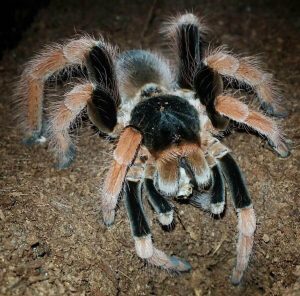Colombian Giant Redleg (Megaphobema robustum)
Megaphobema, New World No Comments »The Colombian Giant Redleg tarantula comes from the tropical rainforests of Colombia and Brazil. Considered an average sized species they reach sizes of 6″ to 8″ in leg span at full growth. Known for their velevet black and red colors they are most definitely a beautiful species. They are fairly quick growers with males reaching maturity within 3 to 5 years and females growing to be up to 15 years old.
Photo Credit: @Andrea.Arachnid
Habitat: The Colombian Giant Redleg is a terrestrial tarantula but can be an obligate burrower. Though their sizes can differ and mature species can be anywhere between 6″ to 8″ we recommend you keep them at full growth in a 10 gallon tank. Make sure you have at least 6″ of substrate to allow your tarantula to burrow should it feel the need to in addition to having a nice startup hide for it. As slings these can be kept in vial and later on a deli cup. Though the more hardier of Megaphobema sp. we recommend you keep the Megaphobema robustum at a slight lower temperature as most tarantulas. We recommend temperatures of 75°F to 84°F with a humidity of 70 to 85%. They do not do well with higher temperatures and a close eye on them should be kept. As always an overflowing water dish should always be kept in the enclosure.
Feeding: Overall great eaters we recommend flightless fruitflies when small slings and later switching it over to small pinhead crickets. Feel free to crush their heads to prevent them hurting your spiderling. You can feed your Megaphobema robustum a mixed variety of crickets, roaches, meal worms and locusts. Be careful of your tarantula being in pre-molt and not wanting to eat. If prey is not eaten within 24 hours of being placed in the enclosure feel free to remove and leave your tarantula alone for at least 1 week as she or he can be ready to molt.
Attitude: Though not aggressive, Megaphobema robustum have urticating hairs which they carry in both their abdomen and back legs. As a defense mechanism they tend to raise their abdomen and flick off a lot of urticating hairs compared to many other species. A fairly shy tarantula they prefer to run then to to show threat posture. They can bite, though harmless, can be equivalent to a bee sting.
A great tarantula overall and definitely should be part of any collection!

